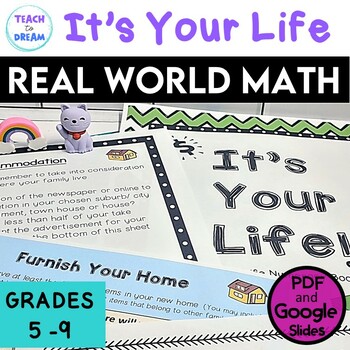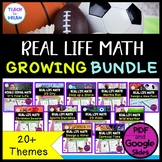Middle School Math Financial Literacy | Real World Summer School Curriculum
- PDF
What educators are saying
Also included in
- Do you want your students to learn financial literacy skills and budgeting in a real life settings? Students will beg to keep learning when they participate in these FUN projects. This bundle will have you covered for YEARS to come...It is SO IMPORTANT that our students learn the vital skills of finPrice $20.30Original Price $29.00Save $8.70
- Make math skills more exciting with these extensive range of Math PBL activities. The growing bundle of real life mini math projects has been developed to be completed by teachers that have limited time. Each Math project covers a range of math skills and provides students with the opportunity to trPrice $54.25Original Price $77.50Save $23.25
Description
Are you looking to make teaching personal financial literacy exciting? This Real World Math budgeting project is perfect for Middle School students and for an end of Year Project.
It will have them looking at budgeting and finance skills as they plan their 'future life'. Student have so much fun during this project and get a real insight into the cost of living.
Are you looking for a financial literacy project that will engage your students?
This unit of work has been designed to allow middle school students to use their math skills in real world setting. Over a series of lessons students learn to budget and understand living costs.
Why this project is great for middle schoolers studying financial literacy?
- Research a job they might like to have when they are older.
- Use Internet sites and/ or newspapers to find accommodation near their workplace.
- Research different modes of transportation and pick the one best suited to their needs (taking into consideration time, location and cost)
- Prepare a weekly meal plan and budget for shopping.
- Find out the bills that they will need to pay.
- Budget and plan for any ‘extras’ or entertainment they wish to experience.
- Have a glimpse of the costs associated with parenthood.
- Prepare a monthly/ yearly budget.
This middle school finance and budget resource includes:
- A print and go booklet covering all of the topics mentioned above.
- Teacher information
- Easy assessment
How this resource can be used:
- End of Year project
- Fast finishers
- Real Life math lessons
- Project based learning
- Homework assignment
~~ Now also includes a Pet page ~~
Resources similar to this one!
- Student Fair - Market Day Project
- Shopping Spree Math Project
- Classroom Re-design Math Project
- Business and Economics Unit
- Student Run Business Project
Related Products
★ Real World Math Projects: 3D City, Distance Learning
★ Real World Math Projects: Design a Hotel, Distance Learning
★ Real World Math Projects: Dine at Mine, Distance Learning
★ Real World Math Projects: Fancy Feast, Distance Learning
★ Real World Math Projects: Shop up a Storm, Distance Learning
★ Real World Math Student Fun Day! Business and Economics, Australian Curriculum
★ Real World Mini Math Projects: 2D Alien Toy, Distance Learning
★ Real World Mini Math Projects: Marble Run, Distance Learning
★ Real World Mini Math Projects: Sports Statistics, Distance Learning
★ Real World Mini Math Projects: Wild Weather, Distance Learning
If you like this resource, you may find my other research projects useful as well. Please have a look at these:
TEACHERS LIKE YOU SAID…
⭐️⭐️⭐️⭐️⭐️ Hayley. W says, "My grade 6 kiddos are having a lot of fun using this engaging and creative math project! I have had many parents provide feedback and praise for the real-world aspects of this project. Along with them, I really do enjoy this aspect. My kiddos enjoy learning when they know why and can see how math concepts can be carried into the real-world. Thank you so much for this resource. It has been very helpful during this trying time."
⭐️⭐️⭐️⭐️⭐️ Carissa says, "My students loved using this and were engaged."
⭐️⭐️⭐️⭐️⭐️ Carol. H says, "I can't describe how much my students and I enjoyed this project. My ALE class was truly engaged and it was an eye opening lesson for them. Thanks so much for your hard work."
~~~~~~ Receive TPT credits to use on future purchases ~~~~~~
Go to your My Purchases page. Next to each purchase you'll see a Provide Feedback button, click it and you will be taken to a page where you can leave a quick rating and a short comment about the product. Each time you provide feedback, you’ll earn TPT credits that can be used for future purchases to save you money! Plus, the feedback you provide helps me make my products better suit your needs!
~~ How to Follow My Store to receive updates and special deals ~~
Click the green star beside my name at the top of this page OR at the top of my store page. Following me notifies you when I post a new item and you will receive emails when products are on sale.
Copyright information:
Purchasing this product grants permission for use by one teacher in his or her own classroom. If you would like to share with others, please purchase an additional license.







